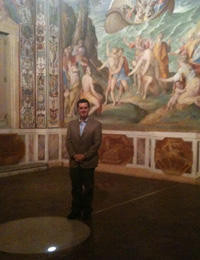'Unlike any office on earth': Kennedy '92 takes viewers inside the Vatican
Bruce Kennedy ’92 stands inside the Tower of the Winds.
When Bruce Kennedy ’92 began working on a documentary about the Vatican, he and his colleagues decided to focus on answering questions that many Americans — whether Catholic or not — have about the institution such as What does the pope do? How much money does the church have? What’s in the Vatican’s secret archives? and How is a pope elected? The two-hour documentary, Secret Access: The Vatican, which Kennedy wrote and directed for Stephen David Entertainment, premieres March 30 on the History Channel.
In each of nine acts, a different topic is covered, said Kennedy, who spent two weeks filming at the Vatican and talking to cardinals, the U.S. Ambassador to the Vatican, as well as Vatican staffers and even people from the fire department.
The show takes viewers beyond the art and grandeur most tourists see and inside the inner workings of one of the largest organizations in the world.
Viewers get a glimpse into Pope Benedict’s apartment. Using footage taken by the pope’s own crew, the documentary shows the pope having lunch in the dining room (his favorite drink is orange soda), watching TV in the living room, and playing classical music on the piano. And the film gives a sense of life in Vatican City, the smallest country on earth, with a grocery store, post office, fire department, and barracks for the Swiss guards who provide security for the pope. “It really is a strange little corner of the world,” said Kennedy, with about 800 residents.
One segment explores America’s relationship with the Vatican. Another act covers the Vatican’s finances and investment funds in its Institute of Religious Works — known as the Vatican Bank. While another segment looks at the secret archives — 16 miles worth of shelving underneath the Vatican — which Kennedy called “unbelievably disorganized.”
The staff that oversees the archives doesn’t know exactly what they have, he said, because over the centuries popes kept changing the way that the archive was cataloged. To make matters worse, the entire archive was taken by Napoleon in the 1800s in boxes and moved to Paris. “A lot was lost,” said Kennedy. The papers eventually were returned to the Vatican, but “they were a mess and they are still recovering from that,” noted Kennedy. “Every day they get a whole new slew of papers from Pope Benedict.”
The documentary covers historical tidbits, including the history of the Vatican’s Tower of the Winds, created by Pope Gregory XIII in the late 16th century “to track the sun,” said Kennedy. A pinhole in one top corner of the room lets sun in and when there is an equinox that light is supposed to hit a particular point on the floor. The room was used to prove that the calendar in use at that time — the Julian calendar — was about 11 days off, and eventually led to the adoption of the Gregorian calendar, which we use today.
Viewers also learn what goes on when cardinals go about electing a new pope and the tradition of the release of white smoke to indicate a new pope has been chosen or black smoke to indicate no decision has been made.
Producing the correct color of smoke, said Kennedy, has proven tricky. “They’ve gotten it wrong several times,” he said. Because it is often decades between the election of a new pope, the officials at the Vatican forget how to create the white and black smoke. When Pope John Paul II was elected, grey smoke confused people. When Benedict was elected, the smoke backed up into the Sistine Chapel. “I guess we should have tested it first,” one cardinal has observed.
“I like the stories that put a face on the Vatican,” said Kennedy. The people who work at the Vatican are “real people, regardless of what you think of the Catholic Church. It’s a couple hundred people trying to run a global organization of 1.1 billion Catholics. They do as well as they can. They make a lot of mistakes. There’s a lot of confusion. There are offices like any other place, only they are part of this 2,000-year tradition, which makes it unlike any office on earth.”












No responses yet